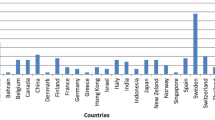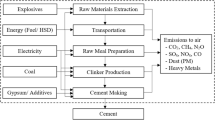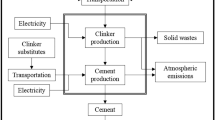Abstract
The purpose of this study is to assess the energy consumption and global warming of Portland cement production in Algeria. A cradle-to-gate Life Cycle Assessment (LCA) for the studied system was developed and conducted according to the LCA-ISO 14040 series. The results obtained were compared to that of a German production process extracted from the GEMIS 4.7 database. The results indicated that the energy requirement in the Algerian process, 5.716 MJ/FU, was higher than in the German process, 4.832 MJ/FU. However, the Green House Gas (GHG) from the Algerian process was less, 551.39 kg CO2 eq/FU, compared with 882.36 obtained for the German process. These could be attributed to the difference in quality of fuels used in the two processes. While the Algerian process was exclusively based on natural gas, the German process was based on a mixture of fuels.
Access provided by Autonomous University of Puebla. Download conference paper PDF
Similar content being viewed by others
Keywords
1 Introduction
Cement is a fundamental element for the civil engineering and habitat sectors. Driven by extensive urbanization, cement production and use have significantly increased. Between 2000 and 2010, world cement production went from 1.73 to 3.35 billion metric tons, and it is expected to reach 4.83 billion metric tons in 2030 (Statistica, 2017).
The cement industry is characterized by its high consumption of energy and raw materials. In China, the world's biggest cement producer, energy needed for cement production represents 7% of the country’s final energy consumption. Moreover, cement production is an important CO2 precursor. In 2013, global CO2 emissions from cement production were 3.6 × 109 t (Salas et al., 2016).
In Algeria, the cement production sector has grown from 11 million tons in 2011 to 12.5 million tons in 2015 and will reach 20 million tons yearly from 2020 (Global Cement, 2017).
This paper aims to conduct an LCA of cement production; “Société des Ciments de Hadjar Soud” (SCHS), which has two dry production lines with a total production capacity of 1 × 106 t/y and low energy efficiency. The results obtained were then compared with a fuel mix-based process (German process) extracted from the GEMIS 4.7 database, to determine how much the quality of the fuel used can influence the plant’s carbon footprint.
2 Methodology
2.1 Life Cycle Assessment
LCA is a method for products and services environmental performance assessment. It is characterized by its ability to take into account the incoming and outgoing flows of the system and to report all this data to a Functional Unit (FU) (ISO, 2006a, 2006b).
2.2 Functional Unit
The goal of this study is to determine the environmental performances of a cement production plant by conducting a “cradle-to-gate” LCA study. The FU chosen for this study is the production of one (1) ton of Portland cement.
Two boundaries define the limits of the system (Fig. 1). They include all operations of cement production. They also cover the required materials and energy for cement production. The cumulative system boundary (broken line) presents inputs used in the system but delivered by processes located outside the studied system boundary. The second border (solid line) is the studied system boundary.
2.3 Life Cycle Inventory and Data Quality
Table 1 presents primary data collected directly from the SCHS factory; these data relate to a FU.
3 Results
3.1 Global Warming Mid-Point Impact
The quantity of GHGs emitted during the production of one ton of Portland cement is 882.36 kg CO2 eq. The main gas related to global warming emitted in the studied system is carbon dioxide (CO2) which represents more than 98% of total global warming impact, while other GHGs, like nitrous oxide (N2O) and methane (CH4), are emitted in very small quantities (1.43% and 0.5%, respectively).
The total amount emitted of carbon dioxide is 865 kg/FU. Clinker production is the main source of emission by 85.22%, of which 62.98% is due to the decarbonization of CaCO3, and 22.34% to the combustion of fuel gas. Electricity generation is the second largest emission source by 12.48%, and finally, the crushing of the raw materials in the extraction phase by 1.87%.
3.2 Cumulative Energy Consumption
The production of a Portland cement FU in the Algerian plant requires 5716.38 MJ of energy (169.11 Nm3). The Algerian process is characterized by an exclusive consumption of natural gas as fuel. Natural gas accounts for 95.31% of the total energy balance, followed by oil 4.49%, and finally, coal by 0.06% (coal and oil are used outside the studied system).
3.3 Comparison of Results
Comparing the results of the Algerian process to those of a German process extracted from the GEMIS database, we can notice that, the German process consumes less energy (4,832.8 MJ), despite that, its carbon footprint is higher than that of the Algerian process (951.36kg CO2 eq) (Fig. 2).
As mentioned above, the Algerian process is based on the unique combustion of natural gas (non-renewable energy). For its part, the energy balance of the German process is based on a mixture of fossils (natural gas 3.29%, oil 16.6%, and coal 67.0%), nuclear energy (8.81%), and part of renewable energies (4.3%) (Fig. 3). This mixture should reduce CO2 emissions, but the high ratio of coal in the energy balance causes an increase in the carbon footprint of the German process.
4 Conclusion
This study was devoted to the environmental performance assessment of a cement plant with low energy efficiency. The results were compared with those of a plant with high-energy efficiency but based on the combustion of a mixture of fuels. By comparing the results of the study, we note that, although the demand for energy in the Algerian process is greater than the world average, its GHG emission is very low. This can be explained by the fact that the Algerian process is based on the combustion of natural gas only. While, worldwide, cement processes are based on a mixture of fossils (natural gas 3.29%, oil 16.6%, and coal 67.0%). The high ratio of coal in the energy balance causes an increase in the carbon footprint.
References
Global Cement. (2017). Two more Algerian plants. Retrieved February 10, 2018. http://www.globalcement.com/news/item/6805-two-more-algerian-plants
ISO. (2006a). ISO 14040. In Environmental management—Life cycle assessment—Principles and framework, 1–28.
ISO. (2006b). ISO 14044. In Environmental management—Life cycle assessment—Requirements and guidelines (7), pp. 652–668.
Salas, D. A., et al. (2016). Environmental impacts, life cycle assessment and potential improvement measures for cement production: A literature review. Journal of Cleaner Production, 113, 114–122.
Statistica. (2017). Major countries in worldwide cement production from 2012 to 2017 (in million metric tons). Retrieved February 10, 2018. https://www.statista.com/statistics/267364/world-cement-production-by-country/
Author information
Authors and Affiliations
Corresponding author
Editor information
Editors and Affiliations
Rights and permissions
Copyright information
© 2023 The Author(s), under exclusive license to Springer Nature Switzerland AG
About this paper
Cite this paper
Makhlouf, A., Kardache, R., Chaabia, R., Drouiche, A., Brahmi, B. (2023). Environmental Impact Assessment of the Algerian Cement Industry: A Case Study with Life Cycle Assessment Methodology. In: Kallel, A., et al. Selected Studies in Environmental Geosciences and Hydrogeosciences. CAJG 2020. Advances in Science, Technology & Innovation. Springer, Cham. https://doi.org/10.1007/978-3-031-43803-5_18
Download citation
DOI: https://doi.org/10.1007/978-3-031-43803-5_18
Published:
Publisher Name: Springer, Cham
Print ISBN: 978-3-031-43802-8
Online ISBN: 978-3-031-43803-5
eBook Packages: Earth and Environmental ScienceEarth and Environmental Science (R0)







